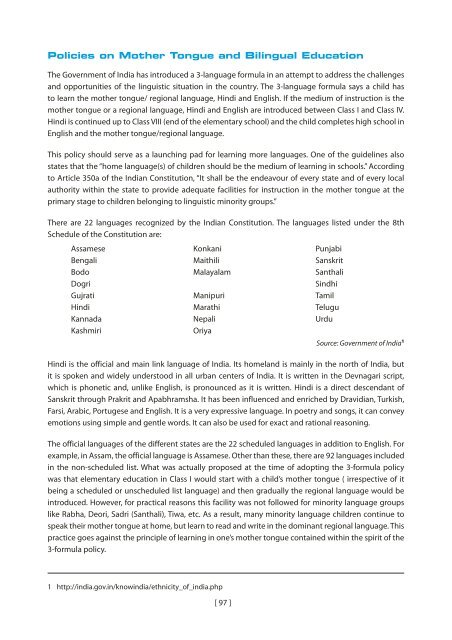Mother Tongue-based Literacy Programmes: Case Studies of Good ...
Mother Tongue-based Literacy Programmes: Case Studies of Good ...
Mother Tongue-based Literacy Programmes: Case Studies of Good ...
You also want an ePaper? Increase the reach of your titles
YUMPU automatically turns print PDFs into web optimized ePapers that Google loves.
Policies on <strong>Mother</strong> <strong>Tongue</strong> and Bilingual EducationThe Government <strong>of</strong> India has introduced a 3-language formula in an attempt to address the challengesand opportunities <strong>of</strong> the linguistic situation in the country. The 3-language formula says a child hasto learn the mother tongue/ regional language, Hindi and English. If the medium <strong>of</strong> instruction is themother tongue or a regional language, Hindi and English are introduced between Class I and Class IV.Hindi is continued up to Class VIII (end <strong>of</strong> the elementary school) and the child completes high school inEnglish and the mother tongue/regional language.This policy should serve as a launching pad for learning more languages. One <strong>of</strong> the guidelines alsostates that the “home language(s) <strong>of</strong> children should be the medium <strong>of</strong> learning in schools.” Accordingto Article 350a <strong>of</strong> the Indian Constitution, “It shall be the endeavour <strong>of</strong> every state and <strong>of</strong> every localauthority within the state to provide adequate facilities for instruction in the mother tongue at theprimary stage to children belonging to linguistic minority groups.”There are 22 languages recognized by the Indian Constitution. The languages listed under the 8thSchedule <strong>of</strong> the Constitution are:AssameseBengaliBodoDogriGujratiHindiKannadaKashmiriKonkaniMaithiliMalayalamManipuriMarathiNepaliOriyaPunjabiSanskritSanthaliSindhiTamilTeluguUrduSource: Government <strong>of</strong> India 1Hindi is the <strong>of</strong>ficial and main link language <strong>of</strong> India. Its homeland is mainly in the north <strong>of</strong> India, butit is spoken and widely understood in all urban centers <strong>of</strong> India. It is written in the Devnagari script,which is phonetic and, unlike English, is pronounced as it is written. Hindi is a direct descendant <strong>of</strong>Sanskrit through Prakrit and Apabhramsha. It has been influenced and enriched by Dravidian, Turkish,Farsi, Arabic, Portugese and English. It is a very expressive language. In poetry and songs, it can conveyemotions using simple and gentle words. It can also be used for exact and rational reasoning.The <strong>of</strong>ficial languages <strong>of</strong> the different states are the 22 scheduled languages in addition to English. Forexample, in Assam, the <strong>of</strong>ficial language is Assamese. Other than these, there are 92 languages includedin the non-scheduled list. What was actually proposed at the time <strong>of</strong> adopting the 3-formula policywas that elementary education in Class I would start with a child’s mother tongue ( irrespective <strong>of</strong> itbeing a scheduled or unscheduled list language) and then gradually the regional language would beintroduced. However, for practical reasons this facility was not followed for minority language groupslike Rabha, Deori, Sadri (Santhali), Tiwa, etc. As a result, many minority language children continue tospeak their mother tongue at home, but learn to read and write in the dominant regional language. Thispractice goes against the principle <strong>of</strong> learning in one’s mother tongue contained within the spirit <strong>of</strong> the3-formula policy.1 http://india.gov.in/knowindia/ethnicity_<strong>of</strong>_india.php[ 97 ]

















